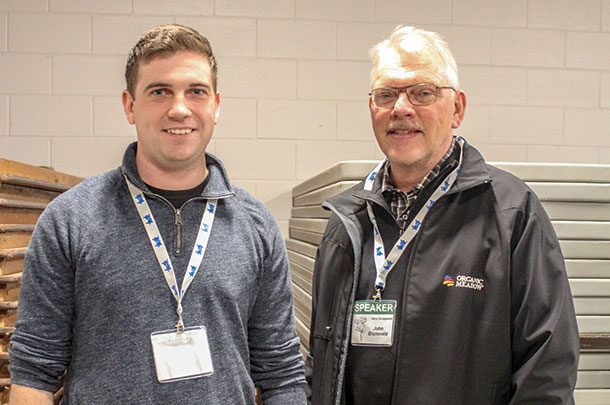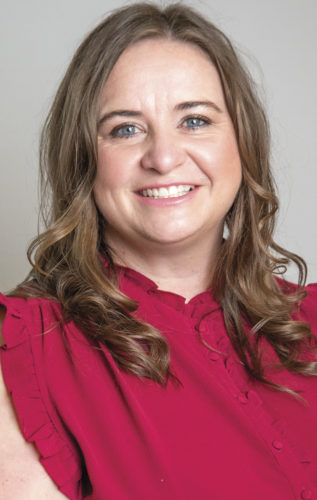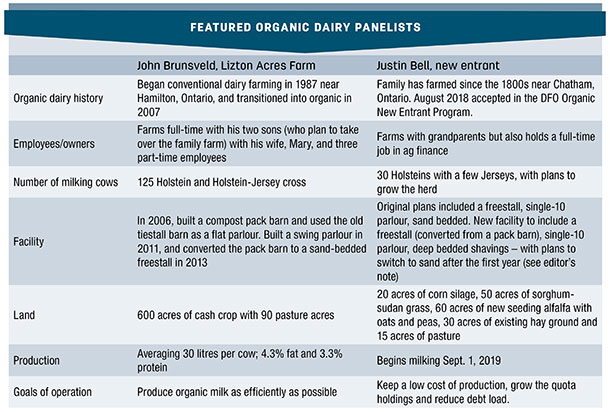To help people better understand how to begin organic production and the challenges along the way, two organic dairy producers shared their stories at the “Organic as a business” panel during the 2019 South Western Ontario Dairy Symposium (SWODS).
John Brunsveld and Justin Bell were at two different stages of organic dairy farming. Brunsveld began farming in 1987, then switched from conventional farming to organic in 2007, and Bell will begin organic production in September 2019.
From the beginning
Brunsveld: I started farming in 1987 and, in 2005, I started thinking about succession planning and the future of a small farm. I had a few situations in my life regarding herbicides and pesticides, and I decided I would look carefully at that particular niche industry [organic]. I wanted to provide an opportunity for the next generation coming in, and we already grazed our cattle for 12 hours every night.
We had some help from some people. Organic Meadows at the time, Jenny Butcher, and a few organic dairy farms that helped put a package together and give me advice.
The other individual who was really helpful to us was George McNaughton, former employee of Dairy Farmers of Ontario (DFO). He was instrumental in answering any questions or put me in contact with people who might have answers.
Bell: My family farms just outside of Chatham. I graduated from Ridgetown College in 2015, bought 100 acres with the support of my grandparents and work full time in ag finance.
[In August 2018] I was accepted into the Organic New Entrant Quota Assistance Program. The application details are on the Dairy Farmers of Ontario website, but basically you need to get a 10-year cash flow together, get an accountant and bank to sign off on it, and enter other qualifying information showing that you’re serious about making it work.
They released that they were going to open the program in April 2018, so I had May and June to get my cash flow together, barn plans and 98% of the quotes from everybody involved in putting the barn together … and sent it off to DFO at the end of June.
The plan
Brunsveld: I live in a particular area where there is a lot of secondary land – it’s hilly and rocky – there are not many farmers right around where I live.
In organic dairy production, you need more acres per animal, so we rented a lot of that vacant land. My simple plan at the time was to compare the numbers to my conventional operation. I wanted to maintain the same quota, ship the same amount of milk or more and, since the grain is very expensive in organics, I wanted to feed a very healthy ration.
I cut grains by two-thirds and grew more forages and rented more land. The plan worked out quite well; the only thing is it was a lot more work to make more forage milking twice as many cows – going from 40 to 80 cows.
I spent all summer long making hay, baleage and so on, but we’ve since streamlined, so it goes a lot quicker now. [For pasture] there are regulations you have to follow – minimum three cows to the acre – and this is bare minimum; you should have more than that.
We pasture during the days in the spring and fall, then at night in the summertime. The minimum is 30% on pasture.
Bell: A lot of people debate between robots or parlours. I plan to maintain my full-time job and a parlour was a lot cheaper, so I ended up putting a parlour in the barn.
I think, long-term, robots may be a viable option. I also planned the barn so I have room for expansion down the road. Starting out with 30 cows, I need to keep the barn as small and as cheap as possible.
There is a half roof split over the feed alley, so down the road I can do a cheap addition on the other side. I think sand is paramount to making the organics work, too. It’s also built so the cows have access to pasture.
Keys to success
Brunsveld: In the conventional world, what always comes up is “litres per cow,” and very rarely does it come up how much grain you’re feeding per cow. Well, in organics, it is number one.
How much starch are you feeding them? And how much milk are you getting for how much starch you are feeding them? Feed costs is one way to look at it. Even though some starch is good, with organics you will find out too much starch leads to too many problems and can have a real drag on the immune system on the animal if you feed them a lot.
We run around 500 acres, and we do grow hay, some corn and some wheat for straw. We had some crop failures … the learning curve was more difficult than what I had anticipated it to be. Our plan for the future is to have more pasture.
The first thing we noticed when we went organic is: We can produce about 14 or 15 litres of milk on straight forages with no grains. Then, with a couple of pounds of mixed grain, you can quickly get up to 20 litres a cow, and then more grain, you go up 25.
Most organic farmers would say that 30 is getting to the danger level, as far as avoiding problems, and reproductive problems and fertility problems, and metabolic disorders and so on.
The problem with getting more production per cow with organic grains is that it is very expensive: two to three times as much the cost of conventional grains. So we’re very careful with how much we feed an animal.
Bell: I tried to get as many ducks in a row before the application was accepted because it is a tight period after they say “OK” and you need to start milking.
My path to success is to limit the stresses on the cows. Find the best feed I can, dry bedding and good-quality pasture.
Networking and learning from others is huge. It seems like everybody I talk to in the organic sector is more than happy to share information with you and try to help so you don’t make the same mistakes they did.
Revenue keeping is definitely huge on the organic side; it seems like big work and a little crazy at times. It’s a little intimidating, but they do work with you to make sure you’re checking all the right boxes.
Why choose to do organic? I needed something to help make a smaller farm more viable. I liked some of the regulations; I liked the cows going out on pasture and, as John said, a little bit less reliance on pesticides or fertilizers; they are expensive too.
It allowed me to build a new barn, and there’s a demand for the milk. There is a premium for the milk right now, and that’s been pretty consistent over the past five to 10 years.
Key points of success:
- Keep the equipment investment to a minimum; let someone else make the payments. [For example,] rent a tractor or a manure spreader.
- Look for a lender or accountant who can help you benchmark your operation. I leaned on some of the people in my group of mentors who are involved in the industry … that is where I started to build my cash flow.
- Strive to keep your cost of production and unnecessary expenses to a minimum.
- Have a five- to 10- to 15-year plan and work towards that.
Challenges and opportunities
Brunsveld stated that his challenges include healthy cattle and controlling weeds and crops (getting his land to produce) whereas, for Bell, he sees his challenge as his learning curve when production begins in September.
Both organic dairy producers attributed their successes to networking. They stressed the importance of talking to other organic dairy producers and offered to help others who are considering transitioning into organic in the future as well.
For the two producers themselves, the future will continue to bring challenges and opportunities.
According to the SWODS proceedings, Brunsveld’s plans include decreasing his cost of production, looking into crossbreeding, and increasing the yields and quality of organic crops.
Bell plans to expand to 100 milking cows and have enough land to support his new dairy operation. ![]()
Editor’s note: Since the South Western Ontario Dairy Symposium, Justin Bell’s plan has undergone a few changes. After realizing that the new farm was too isolated from the current milk route in Chatham, he decided to buy a 200-acre farm near Peterborough – more central to other organic dairy farms. The new farm has existing barns (a pack barn to be converted to freestalls) and will save over $10,000 a year in transportation costs. He still plans to milk Sept. 1 and, as the land is already certified organic, he will be able to produce all of the feed he needs on his own ground.
PHOTO: Justin Bell and John Brunsveld discussed their individual experiences in organic dairy production during the 2019 South Western Ontario Dairy Symposium in Woodstock, Ontario. Photo by Lora Bender.

-
Lora Bender
- Editor
- Progressive Dairyman
- Email Lora Bender
Click here or on the image above to view it at full size in a new window.










